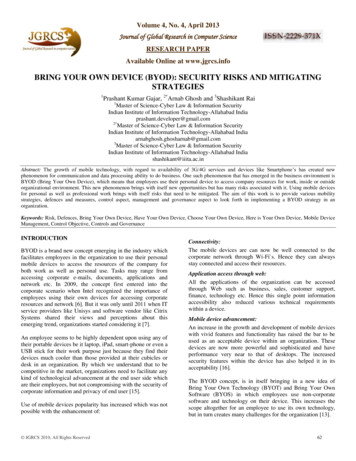
Transcription
How to Do Your OwnRevenue and PricingAnalysis2013 Users Conference7/19/13Tim Proctor (tim@pcc.com)Goals and Takeaways My overall goals for today's session:–Help you understand why you'd want toreview charges and revenue–Help you get familiar with PCC's tools foranalyzing revenue and pricing–Do your own revenue and pricing analysis! Are your prices adequate?Your goals?Revenue Analysis Why do it?Find out if you could be doing betterRecognize trends in practice revenue– “Am I suddenly getting paid more or lessthan I used to?”– Homework for insurance negotiations––
Per-Visit Analysissrs Visit Reports Per-Visit Analysis (activity style)Press F8 to addrestriction criteria of“VISIT Amount Duefor Visit” and specify 0 to 0. Thisensures you are onlylooking at paid visits.Per-Visit AnalysisCompare “AVG Deposited Per Visit” among payors. Which areyour best and worst payors?Special Circumstances Capitated plans – be sure to add up capitationpayments and fee-for-service revenue to get true, totalcapitated plan revenue
Special Circumstances Non-Revenue Services such as no-show or form fees caninflate total visits. If you have a lot of these, restrict the report toinclude only revenue services or else your revenue-per-visittotals will be deflated.Add restriction criteriaof “VISIT IncludeOnly RevenueCharges.” This willreport accurate visittotals but note thatthis non-servicerevenue won't beincluded on thereportReimbursement Analysis by CPT Codesrs Charge Reports Reimbursement Analysis by CPT Code When prompted,select your mostcommon proceduregroupsPress F8 to addrestriction criteria ofCHARGE AmountDue for Visit.” Thisensures you areonly looking atpaid visits.Are any insurance companies paying you at or near your chargeamount?Time to raise prices!
Allowable Underpayments Reportsrs Payment and Proving Out Reports Allowable Underpayments Report (Subtotal bySchedule) Identifies payments that were made below theconfigured allowed amountMiscellaneous Revenue Be sure to post all revenue (ARRA incentives,P4P bonuses, etc) Use “Office”provider unlessthe bonus is fora specificprovider
Miscellaneous Revenue Offset thepaymentappropriately toavoid credit on theholding account“Bonus PaymentOffset” should be“Revenue-NonService”accounting typeProcedure Accounting TypesAvailable accountingtypes: Receipt Receipt-NSF Receipt-Refund Revenue Revenue-CPT II Revenue-Credit W/O Revenue-Non Service Revenue-Svc ChgProcedure Accounting TypesAccounting TypeBrief DescriptionExamplesRevenueWork performed by providers.Anything with a valid, billable CPTcode should most likely be assigned“Revenue”Anything with a valid, billableCPT codeRevenue - Credit W/OWhen you've had a credit on anaccount for a while, and you knowyou are not going to return themoney, you need to book it as realrevenue/profit. It's not anadjustment, or the reverse of one.Revenue - Svc ChgService charges or billing feesRecord transfer fees, missedappointment fees, form fees, etcRevenue - Non-serviceNon-service procedures or offsetsCapitation offsets, insurancetakebacks, etcReceiptOther adjustments decreasingreceipts.Receipt - NSFBounced checks.NSF CheckReceipt - RefundInsurance or patient refunds.Patient Refund, InsuranceRefund/Takebacks
How Should You Set YourPrices? Using standard system called RBRVS–– Resource Based Relative Value ScaleUgly mathPCC's “Pricing Analysis” srs report will dothe ugly math for youRBRVS-Resource BasedRelative Value Scale Method to quantify the value and price of everyprocedure while adjusting for geographic location Government implemented system on Jan 1, 1992 Relative Value Unit is assigned to every CPT code New RVU values are released every year Almost all public and private payors usecomponents of Medicare RBRVS to reimbursephysicians.Why RBRVS? All of the insurance companies utilize the RBRVSsystem in one way or another. It's the standard.With the arrival of HSAs and HDHPs, practices need apricing system that substantiates their worth.With PCC's RVU calculators, it's fast and easy.
Why RBRVS? It allows you to compare your practice to others.It is potentially an effective provider productivitymeasurement.Most of all: it's guaranteed to increase your income,if only a little.Components of an RVUValue for each procedure is based onthree components: Physician work that goes into service( 52% of total RVU value) Practice expense for the service( 44% of Total RVU) Professional liability expense for theservice ( 4% of Total RVU)Geographic Practice Cost Index(GPCI)Costs associated with practicing in Manhattan are muchdifferent than costs for practicing in, say, Mobile, ALGeographic adjustment is made to each component of anRVUSample 2009 GPCI:Medicare LocalityNameSuburban Chicago, ILChicago, ILRest of IllinoisMetropolitan BostonRest of Mass.Fort Lauderdale, FLMiami, FLRest of 671.724
Calculating an RVU2010 RVU Value of 99213 (Office Visit Level 3) fora practice in Burlington, VT:(Work RVU * Work GPCI) (Practice Expense RVU * PE GPCI) (Malpractice Expense RVU * ME GPCI) (0.97 * 0.968) (0.80 * 0.983) (0.05 * 0.489) 1.75How Does an RVU ValueTranslate Into a Price? Medicare Conversion Factor–National value used to convert procedure RVUvalues into reimbursement amounts–Medicare reimbursement amount for 1 (one) RVU.–Updated annuallyHow Does an RVU ValueTranslate Into a Price?Multiply RVU value by Medicare conversion factorto calculate Medicare valueFor a practice in Burlington, VT here is the annualvalue for 99213:2013 RVU Value2013 MedicareConversionFactor2013 MedicareValue2.12 34.02 72.04
Appropriate RBRVS MultiplierOK, that's the system . but how much more should I chargeabove the Medicare value?Typical Pediatric Pricing9921399214150%160%992159939199392145%140%% of te RBRVS MultiplierPick the pricing level that's right for your practice . anddon't go under it!Appropriate Pediatric 92155%140%% of Medicare120%100%80%60%40%20%0%Setting Your PricePick a year and an appropriate multiplier, then setyour price based on the Medicare value for thatyearExample: Based on 2013 RVU values for Burlington,VT location:CPT CodeMedicare ValueYour MultiplierYour Price99213 72.04160%( 72.04 * 1.60) 115.27
Pediatric Pricing BenchmarkPick the pricing level appropriate foryour practice .PCC Pediatric Benchmark, 2013:156% of MedicarePediatric Pricing BenchmarksAverage Pricing, 2013: 156%90th Percentile:194%10th Percentile:131%% of Medicare2013 Pricing Level by st No East So Mid AtCentral Central lantic157%167%163%150%171%150%Moun NewPacific South West No West SotainEnglandAtlantic Central CentralSetting Your Pricing Level Know your insurance contractsRule of thumb: Charge at least 20% higher than therates that your best payor would pay you
Define Report CriteriaBNA Adjustment onlyapplicable for 2007/2008Pricing Analysis ReportRVU Status Code – Every procedure is assigned a status code by MedicarePricing Analysis ReportUnits – Actual number of units performed for the procedure in the date rangeselected.Number of Valid RVU Units – This is “0” for procedures that have an RVU valueof 0. This includes imms, injections, and some lab procedures.
Pricing Analysis ReportTotal Number of RVUs “AVG RVU per Unit” * “Number of Valid RVU Units”Avg RVU Per Unit – The RVU value for the procedure for the database yearselected and adjusted by the selected GPCI location factors.Pricing Analysis ReportAVG Charge Amount “Charge Amount” / “Units”. This represents yourcurrent price for the procedureAVG Deposited Amount “Amount Deposited” / “Units”. This represents howmuch you collect for the procedure on average.Pricing Analysis ReportRVU Practice FACF – This column represents what your price would be if youcharged at the average pricing level you use for all other procedures.
Pricing Analysis ReportRVU Medicare FACF – This is the Medicare-assigned dollar value of theprocedure for the database year selected.Calculation: (Medicare Conversion Factor for database year) * “AVG RVU PerUnit”Pricing Analysis ReportAVG Deposited as Percent of MCare FACF “Avg Deposited” / “RVU MedicareFACF”. This represents how much you are getting paid for the procedure “as apercent of Medicare” for the database year selected.Pricing Analysis ReportRVU Medicare FACF at X% This column represents the price of theprocedure code at X% of Medicare. X% is whatever you used as the“RVU Multiplier” on the criteria page.Calculation “RVU Medicare FACF” * “RVU Multiplier”
Pricing Analysis ReportUnderbilled Amount This represents how much you have undercharged forthe procedure.Calculation (“AVG Charge Amount” - “RVU Medicare FACF at X%”) * “Units”Suggestion Quickly “eyeball” the “Underbilled Amount”column to identify which procedures you may beundercharging for.High negative numbers in this column indicatemore drastic undercharging. Positive numbers or 0indicate a sufficient price based on the level youchose.Setting Prices ForImmunizations Use RBRVS method for pricing immunizationadministrationImmunizations have RVU value of 0, so 0 price willshow in RVU reportCDC guide showing AWP (Average Wholesale rdees/vaccine-management/pricelist/index.html AAP resources for vaccine cians/financing.html Recommendation: Seek vaccine reimbursement rate of 1728% above your direct purchase price.
Setting Prices For Clinical LabProcedures Refer to CMS “Clinical Laboratory Fee hed/01 overview.asp
Revenue and Pricing Analysis 2013 Users Conference 7/19/13 Tim Proctor (tim@pcc.com) Goals and Takeaways My overall goals for today's session: -Help you understand why you'd want to review charges and revenue -Help you get familiar with PCC's tools for analyzing revenue and pricing -Do your own revenue and pricing analysis!











